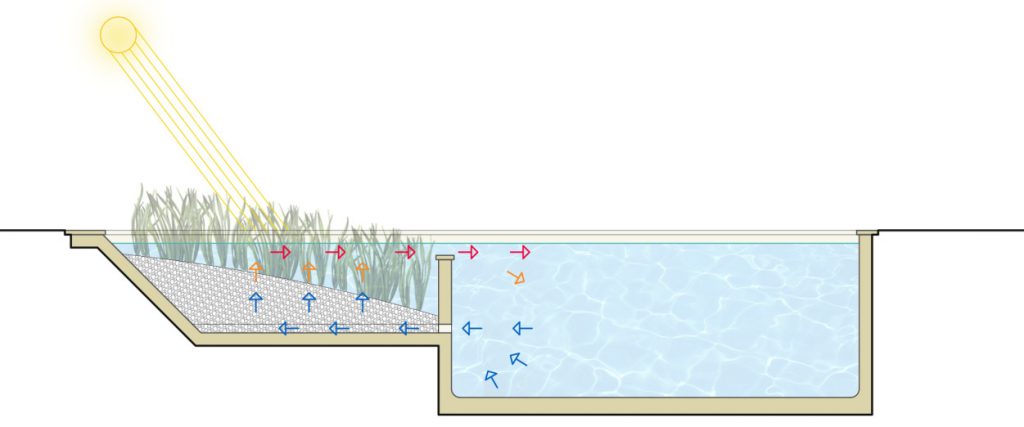At SingularGreen, we know that keeping a pool in optimal conditions is crucial to ensure the safety and cleanliness of the water.
In conventional pools, the use of biocides is essential to prevent the proliferation of harmful microorganisms such as bacteria, algae and fungi.
These chemicals are indispensable to ensure that the water is kept in perfect condition. However, it is important to note that natural pools, such as the ones we design and build, do not require biocides, as we use ecological methods to maintain the balance of the water.
Our experience with purification systems in natural pools has taught us that the correct management of natural resources can eliminate the need for biocides.
In these systems, the biological balance, particularly through the use of zooplankton, plays a key role in the elimination of pathogens, allowing for a safe and chemical-free environment.

What are biocides and why are they essential for conventional swimming pools?
Biocides are chemicals designed to prevent and control the growth of unwanted organisms in the water of conventional swimming pools. Their role is essential to ensure that these pools are kept free of micro-organisms that can affect the health of users and the quality of the water.
At SingularGreen, we focus on systems that avoid dependence on these products.
In our natural pools, zooplankton and aquatic plants work together to keep the water in balance, eliminating the need for biocides. This approach is not only more sustainable, but also safer for the environment and for those who enjoy the pool.
Types of Biocides Used in Conventional Pool Treatment
Each type of biocide has its own specific function and can be oxidising or non-oxidising. Each has specific characteristics that make them more suitable for different situations.
There are different types of biocides, each with specific characteristics that make them more suitable for certain uses:
- Algaecides: Specially designed to combat algae growth, which can make water turbid and slippery.
- Fungicides: Which prevent fungal growth, a concern in pools that are not properly maintained.
- Oxidants: Such as chlorine and bromine, which kill micro-organisms by breaking down their cell structures.
Oxidising biocides
- Stability: They are not very stable, which means that they break down quickly in water.
- Persistence: They persist in water for short periods.
- Corrosivity: They are corrosive, which can adversely affect pool equipment and structures.
- pH dependence: Their activity depends on the pH level, being more effective in certain ranges.
- Penetration in biofilm: They have little capacity to penetrate biofilm, a protective layer that some micro-organisms can form.
- Contact time: They act quickly, so they need little contact time to be effective.
Non-oxidising biocides
- Stability: They are more stable and maintain their effectiveness for longer.
- Persistence: They are more persistent in water.
- Corrosivity: They are not corrosive, which makes them safer for equipment and surfaces.
- pH dependency: Their activity is not dependent on pH level, making them more versatile.
- Biofilm penetration: They have a high penetration power in biofilm, which allows them to eliminate microorganisms protected by this layer.
- Contact time: They need more contact time, but they are very effective in the elimination of pathogens.
Effectiveness of biocides in different types of pools
The effectiveness of biocides varies depending on the type of pool and the specific water conditions. In conventional pools, it is essential to choose the right biocide and use it correctly to keep the water clean and safe.
Biocides in conventional pools
In conventional pools, biocides are indispensable to prevent the proliferation of micro-organisms. Depending on the biocide, water quality can be effectively managed, preventing problems such as algae growth or the appearance of pathogenic bacteria.
The Role of Zooplankton in Natural Pools
At SingularGreen, we pride ourselves on designing and building natural pools that do not rely on biocides.
Instead of chemicals, our pools use natural filtration systems, where zooplankton play a crucial role.
These tiny organisms feed on bacteria and other pathogens, keeping the water clean and safe in a natural way. In addition, the combination of natural filters and aquatic plants oxygenates and purifies the water, creating a self-sufficient and ecological environment.
Comparison between biocides and other disinfection methods
Conventional pool owners often find themselves debating between the use of oxidising biocides, non-oxidising biocides and other disinfection options such as salt chlorine.
Oxidising vs. non-oxidising biocides
Oxidising biocides are fast acting, but less stable and more corrosive. They are useful when rapid disinfection is needed, although prolonged use may require frequent adjustments and may adversely affect pool installations.
On the other hand, non-oxidising biocides, while requiring more contact time, are more stable and non-corrosive, making them a safer option for continuous use.
The role of salt chlorine as an alternative to biocides
Salt chlorine is another popular option for conventional pools.
This method generates chlorine from salt dissolved in the water by electrolysis, providing consistent and less aggressive disinfection than traditional biocides.
However, as we at SingularGreen have found, this method is neither necessary nor recommended for natural pools.
Considerations and regulations on the use of biocides
The use of biocides in conventional pools is strictly regulated to ensure that they are used safely and effectively, protecting both users and the environment.
Current Regulations on the Use of Biocides in Conventional Swimming Pools
In Spain, the use of biocides is subject to regulations that establish how these products must be handled, the permitted concentrations, and the precautions that must be taken during their application.
At SingularGreen, we consider it essential that conventional pool owners follow these regulations to avoid legal problems and ensure the safety of swimmers.
Safety and Precautions in Handling Biocides
Biocides should be handled with care, always following the manufacturer’s instructions.
It is essential to use appropriate protective equipment and to store these products in safe places, out of reach of children and pets.
In our natural pools, the elimination of biocides and the implementation of natural purification systems eliminate these risks, making the environment safer and more sustainable.
Pool water maintenance with biocides
For biocides to be effective, regular and careful maintenance of the pool water is necessary. This includes frequent testing of pH and biocide levels, as well as proper cleaning of filters and other equipment.
Steps to effective maintenance
In conventional pools, effective maintenance begins with regular monitoring of biocide and pH levels. These must be kept within recommended ranges to avoid health and water quality problems.
At SingularGreen, we have developed natural pool systems that require much simpler maintenance, as the biological balance and natural filtration system minimises the need for chemical adjustments.
Solving Common Problems When Using Biocides
One of the most common problems with biocides is under- or over-dosing, which can lead to problems such as skin irritation or the growth of micro-organisms. Maintaining a maintenance routine and adjusting dosages as needed is key to avoiding these problems.
Tips for Extending the Lifetime of Biocides
To prolong the effectiveness of biocides, it is important to store them properly and combine them with a good filtration system.
At SingularGreen, we ensure that our natural pools are self-sufficient and sustainable, eliminating the need for biocides and significantly reducing long-term maintenance costs.






